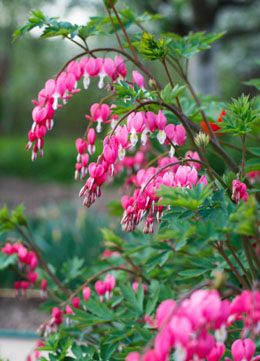One of the popular ornamental plants, the bleeding heart plant has heart-shaped flowers with dangling tips. Go through this article to know more about some bleeding heart plant facts.
 Bleeding heart
Bleeding heart! What an amazing name for a plant! Like the name, the plant too is fascinating with spectacular heart-shaped flowers. These pink-colored flowers have small dangling tips that are compared to drops of blood. In fact, the most attractive part of a bleeding heart plant is its flowers. Native to China, Japan and certain other regions of Asia, these plants are now grown in various parts of the world, for ornamental purposes. If you are interested in knowing more about this plant, continue reading this Buzzle article.
Bleeding Heart Taxonomy
Bleeding heart plant (
Lamprocapnos spectabilis) belongs to the genus
Lamprocapnos in the family
Fumariaceae. This species was earlier classified as a member of the genus
Dicentra in the same family. So, formerly, the plant was known as
Dicentra spectabilis. It has various other names like lyre's flower, lady in a bath, Venus's car and Dutchman's trousers. The plant is often confused for other plants, like, bleeding heart vine (a member of the
Verbenaceae family) and some of the members of the genus
Dicentra. However, you can recognize a bleeding heart with its heart-shaped flowers.
Bleeding Heart Plant Characteristics
The all-time favorite among garden growers,
Lamprocapnos spectabilis is now available in various types. While the different bleeding heart varieties vary in foliage and flower color, the old one can be recognized with the pink-colored flowers having white dangling tips. The leaves are compound with three leaflets and the stems are almost pinkish green in color. The plant size may vary with the different varieties, but they may grow to a maximum height of three feet. The flowers are produced on racemes that grow in a horizontal fashion. Each of these hanging flowers has a length of one to two inches. These plants are found to produce flowers during late spring to early summer. As mentioned above, the flowers have pink petals on the outside and the inner parts are white, with white dangling tips. Being deciduous in nature, these plants lie dormant after the blooming season, but grows back the next spring.
Bleeding heart is one of those poisonous ornamental plants and it is not advisable to ingest any part of this plant. They must be handled carefully, as these plants can cause skin irritation too. The above mentioned characteristics are that of old-fashioned
Lamprocapnos spectabilis. The cultivars may have different characteristics. You may find the variety named 'Gold heart' with yellowish green foliage. Another variety called fern-leaf bleeding heart has beautiful cut-leaf foliage. The cultivar termed 'Alba' produces white flowers and is commonly known as white bleeding heart. Though the 'old-fashioned' type is highly popular, the new varieties are also in demand. If you are interested in growing this plant, you may opt for the variety you like. Now that you have a fair idea about some interesting facts about bleeding heart plant, let us take a look at how to grow them.
How to Care for Bleeding Heart Plants?
Bleeding hearts are considered as shade-loving plants. However, some of them can tolerate full sun, if you maintain the moisture of the soil. They love moist soil and cool weather. The soil for planting them must be fertile as well as well drained. You have to apply a good amount of compost around the plant during spring. Get a healthy plant from the nursery during spring and plant it in a location with partial shade. You may add a small amount of fertilizer while planting a bleeding heart. Once the blooming season is over, you may trim the dying foliage. If the cultivar you have planted has foliage that remains throughout the year, you have to water the plant regularly. These plants are less prone to diseases and pests. In case of leaf spots, remove the affected parts.
In short, bleeding heart plants are highly popular for their spectacular flowers as well as the ease of growing. You can get some of them and enhance the beauty of your garden. This article is only for informational purposes. So, it will be better to gain some knowledge about how to grow a bleeding heart, before you start growing them in your garden.






 Bleeding heart! What an amazing name for a plant! Like the name, the plant too is fascinating with spectacular heart-shaped flowers. These pink-colored flowers have small dangling tips that are compared to drops of blood. In fact, the most attractive part of a bleeding heart plant is its flowers. Native to China, Japan and certain other regions of Asia, these plants are now grown in various parts of the world, for ornamental purposes. If you are interested in knowing more about this plant, continue reading this Buzzle article.
Bleeding heart! What an amazing name for a plant! Like the name, the plant too is fascinating with spectacular heart-shaped flowers. These pink-colored flowers have small dangling tips that are compared to drops of blood. In fact, the most attractive part of a bleeding heart plant is its flowers. Native to China, Japan and certain other regions of Asia, these plants are now grown in various parts of the world, for ornamental purposes. If you are interested in knowing more about this plant, continue reading this Buzzle article.